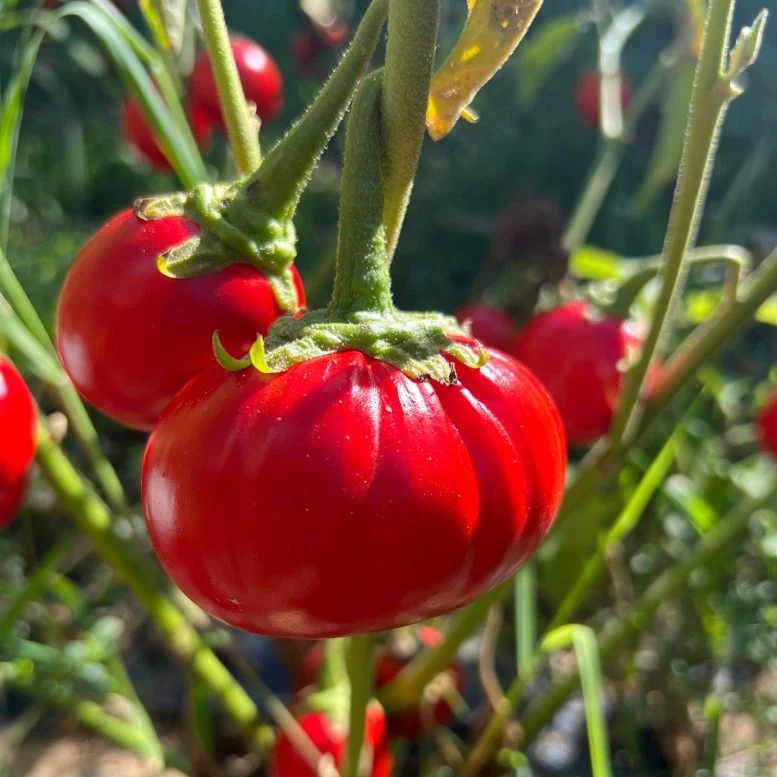博文
CRISPR的突破揭开了超大尺寸农产品的基因蓝图
 精选
精选
||
CRISPR的突破揭开了超大尺寸农产品的基因蓝图
诸平
据美国约翰·霍普金斯大学(Johns Hopkins University)2025年3月5日提供的消息,CRISPR的突破揭开了超大尺寸农产品的基因蓝图(CRISPR Breakthrough Unlocks the Genetic Blueprint for Super-Sized Produce)。
一项基因上的突破可能很快就会给世界带来更大更好的西红柿和茄子。(A genetic breakthrough may soon bring bigger and better tomatoes and eggplants to the world.)
科学家绘制了茄类作物(nightshade crops)的基因组图谱,发现了决定果实大小的关键基因。
有了CRISPR,他们找到了控制这些基因的方法,为生产更大、更美味的产品铺平了道路。
更大、更美味的西红柿即将问世(Bigger, Tastier Tomatoes on the Horizon)
约翰·霍普金斯大学和冷泉港实验室(Cold Spring Harbor Laboratory)的一组科学家表示,更大、更美味的西红柿和茄子可能很快就会成为现实。他们的研究已经确定了影响果实大小的关键基因,为开发既能提高口感又能提高农业效率的新作物品种铺平了道路。
这一突破可能导致改良的传家宝番茄和茄子品种的发展,特别是在现有的当地作物太小而无法大规模种植的地区。通过种植更大、更具商业可行性的农产品,这些发现有可能支持全球农业。相关研究结果于2025年3月5日已经在《自然》(Nature)杂志发表——Matthias Benoit, Katharine M. Jenike, James W. Satterlee, Srividya Ramakrishnan, Iacopo Gentile, Anat Hendelman, Michael J. Passalacqua, Hamsini Suresh, Hagai Shohat, Gina M. Robitaille, Blaine Fitzgerald, Michael Alonge, Xingang Wang, Ryan Santos, Jia He, Shujun Ou, Hezi Golan, Yumi Green, Kerry Swartwood, Nicholas G. Karavolias, Gina P. Sierra, Andres Orejuela, Federico Roda, Sara Goodwin, W. Richard McCombie, Elizabeth B. Kizito, Edeline Gagnon, Sandra Knapp, Tiina E. Särkinen, Amy Frary, Jesse Gillis, Joyce Van Eck, Michael C. Schatz, Zachary B. Lippman. Solanum pan-genetics reveals paralogues as contingencies in crop engineering. Nature, 5 March 2025. DOI: 10.1038/s41586-025-08619-6. https://www.nature.com/articles/s41586-025-08619-6
参与此项研究的除了来自美国约翰·霍普金斯大学(Department of Genetic Medicine, Johns Hopkins School of Medicine, Baltimore, MD, USA; Department of Computer Science, Johns Hopkins University, Baltimore, MD, USA)的研究人员之外,还有来自美国冷泉港实验室(Howard Hughes Medical Institute, Cold Spring Harbor Laboratory, Cold Spring Harbor, NY, USA; Cold Spring Harbor Laboratory, Cold Spring Harbor, NY, USA; School of Biological Sciences, Cold Spring Harbor Laboratory, Cold Spring Harbor, NY, USA)、美国纽约塞托克特的SiteKicks.ai(SiteKicks.ai, Setauket, NY, USA)、美国伊萨卡的博伊斯·汤普森研究所(Boyce Thompson Institute, Ithaca, NY, USA)、哥伦比亚国立大学(Max Planck Tandem Group, Facultad de Ciencias, Universidad Nacional de Colombia, Bogotá, Colombia)、哥伦比亚卡塔赫纳大学(Departamento de Biología, Facultad de Ciencias Exactas y Naturales, Universidad de Cartagena, Cartagena de Indias, Colombia)、乌干达基督教大学(Faculty of Agricultural Sciences, Uganda Christian University, Mukono, Uganda)、加拿大圭尔夫大学(Department of Integrative Biology, University of Guelph, Guelph, Ontario, Canada)、英国爱丁堡皇家植物园(Royal Botanic Garden Edinburgh, Edinburgh, UK)、英国伦敦自然历史博物馆(Natural History Museum, London, UK)、美国南哈德利的芒·霍利奥克学院(Department of Biological Sciences, Mount Holyoke College, South Hadley, MA, USA)、加拿大多伦多大学(Physiology Department and Donnelly Centre for Cellular and Biomolecular Research, University of Toronto, Toronto, Ontario, Canada)以及美国伊萨卡的康奈尔大学(Plant Breeding and Genetics Section, School of Integrative Plant Science, Cornell University, Ithaca, NY, USA)的研究人员。
农业的基因革命(A Genetic Revolution in Agriculture)
参与了人类端粒到端粒基因组计划的美国约翰·霍普金斯大学的遗传学家迈克尔·沙茨(Michael Schatz)说:“一旦你完成了基因编辑,只需要一颗种子就能开始一场革命。只要获得批准,我们就可以把转基因种子邮寄到非洲或任何需要它的地方,从而打开全新的农业市场。将这些进步转化为现实影响的潜力巨大。”
这项研究是一项更广泛的计划的一部分,该计划旨在绘制22种茄类作物的全基因组图谱,包括西红柿、土豆和茄子,以更好地了解和增强它们的遗传特征。
通过计算分析,研究人员比较了基因组图谱,并追踪了这些基因是如何随着时间的推移而进化的:研究人员发现,超过一半的基因在过去的某个时候被复制过。
解开基因复制的秘密(Unlocking the Secrets of Gene Duplication)
迈克尔·沙茨说:“在数千万年的时间里,DNA序列不断地增加和减少。同样的过程也可以发生在基因序列上,整个基因复制或消失。当我们开始观察时,我们注意到这些变化非常普遍,但我们还不知道这些变化对植物意味着什么。
为了找到答案,博伊斯·汤姆森研究所的合作者使用CRISPR-Cas9基因编辑技术来调整一个基因的一个或两个副本,冷泉港的合作者种植了经过改造的植物,看看这些调整是如何改变成熟植物的。”
基因重复,或类似,最终对决定开花时间、果实大小和果实形状等特征很重要。例如,在澳大利亚原产的森林茄类植物中,关闭CLV3基因的两个副本,导致研究人员描述的植物形状怪异,气泡状,杂乱无章,无法在杂货店作为农产品出售。但是,对CLV3的一个拷贝进行仔细的编辑,就能产生更大的果实。
基因秘密的藏宝图(A Treasure Map of Genetic Secrets)
拥有这些物种的完整基因组序列就像拥有了一张新的藏宝图。当时在迈克尔·沙茨实验室攻读博士学位的凯瑟琳·杰尼克(Katharine Jenike)表示:“我们可以看到一个基因路径与另一个基因路径在何时和何处出现分歧,然后在遗传信息中探索我们没有想到的地方。它们让我们在一个意想不到的地方发现了大小基因。”
在非洲茄子(African eggplant)中,研究人员发现了一种类似SaetSCPL25的基因,它控制着果实内的种腔或小室的数量。非洲茄子是一种在非洲大陆和巴西种植的可食用水果和叶子。当他们在番茄植物中编辑SaetSCPL25样基因(SaetSCPL25-like genes)时,研究人员发现他们可以种植出具有更多小室的番茄:小室越多,番茄就越大。
研究人员说,如果处理得当,这一发现将开启美味西红柿的新时代。
美味丰富的农产品的未来(A Future of Flavorful, Plentiful Produce)
迈克尔·沙茨说:“这项工作显示了一起研究许多物种的重要性。我们利用几十年来在番茄遗传学方面的工作,迅速促进了非洲茄子(African eggplants)的发展,在这个过程中,我们在非洲茄子中发现了全新的基因,这些基因相互促进了番茄的发展。我们称之为泛遗传学(‘pan-genetics’),它提供了无限的机会,将许多新的水果、食物和口味带到世界各地的餐桌上。”
该研究得到了法国国家农业、食品和环境研究所(INRAE)的植物健康和环境部{Plant Health and Environment department of the French National Institute for Agriculture, Food and Environment (INRAE)}、美国国家科学基金会生物学博士后奖学金{NSF Postdoctoral Fellowship in Biology (IOS-2305651)}、美国冷泉港生物科学学院的威廉·伦道夫·赫斯特奖学金(William Randolph Hearst Scholarship from the Cold Spring Harbor School of Biological Sciences)、美国俄勒冈州立大学STEM教育教师启动奖(OSU STEM Education Faculty Startup Award)、全球网关倡议基金(Global Gateways Initiative Grant)、哥伦比亚国立大学与Minciencias(Convenio 566 of 2014 between Universidad Nacional de Colombia and Minciencias)、哥伦比亚国立大学研究基金(UCU Research Funds)、美国国家科学基金会行星生物多样性倡议{NSF Planetary Biodiversity Initiative grant ‘PBI Solanum: a worldwide initiative’ (DEB‐�316614)}、西布尔德信托(Sibbald Trust)、加拿大魁北克研究基金——自然与技术博士后奖学金(Fonds de recherche du Québec—Nature et Technologies postdoctoral fellowship)、英国国家地理学会北欧奖(National Geographic Society Northern Europe Award GEFNE49-12)、美国国立卫生研究院(National Institutes of Health grant R01MH113005)、美国国家科学基金会植物基因组研究计划(National Science Foundation Plant Genome Research Program grant IOS-2216612)以及美国霍华德·休斯医学研究所(Howard Hughes Medical Institute)的资助。
上述介绍仅供参考,欲了解更多信息敬请注意浏览原文和相关报道。
Scientists Discover Genes To Grow Bigger Tomatoes And Eggplants
Pan-genomics and genome-editing technologies are revolutionizing breeding of global crops1,2. A transformative opportunity lies in exchanging genotype-to-phenotype knowledge between major crops (that is, those cultivated globally) and indigenous crops (that is, those locally cultivated within a circumscribed area)3,4,5 to enhance our food system. However, species-specific genetic variants and their interactions with desirable natural or engineered mutations pose barriers to achieving predictable phenotypic effects, even between related crops6,7. Here, by establishing a pan-genome of the crop-rich genus Solanum8 and integrating functional genomics and pan-genetics, we show that gene duplication and subsequent paralogue diversification are major obstacles to genotype-to-phenotype predictability. Despite broad conservation of gene macrosynteny among chromosome-scale references for 22 species, including 13 indigenous crops, thousands of gene duplications, particularly within key domestication gene families, exhibited dynamic trajectories in sequence, expression and function. By augmenting our pan-genome with African eggplant cultivars9 and applying quantitative genetics and genome editing, we dissected an intricate history of paralogue evolution affecting fruit size. The loss of a redundant paralogue of the classical fruit size regulator CLAVATA3 (CLV3)10,11 was compensated by a lineage-specific tandem duplication. Subsequent pseudogenization of the derived copy, followed by a large cultivar-specific deletion, created a single fused CLV3 allele that modulates fruit organ number alongside an enzymatic gene controlling the same trait. Our findings demonstrate that paralogue diversifications over short timescales are underexplored contingencies in trait evolvability. Exposing and navigating these contingencies is crucial for translating genotype-to-phenotype relationships across species.
https://wap.sciencenet.cn/blog-212210-1476273.html
上一篇:战胜失眠的最佳运动
下一篇:与中风风险和严重程度相关的10种生活方式因素
